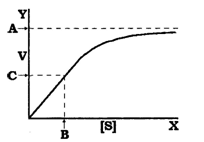Activation energy:
(1) Is the difference in the average energy content of 'S' from that of its transition state
(2) Helps to change reactants into unstable transition state before they can be converted into products
(3) Is minimum energy required from outside to overcome the energy barrier of reactant or to start a reaction
(4) All are correct
(1) Is the difference in the average energy content of 'S' from that of its transition state
I. Segment representing the energy of activation.
II. Segment representing the amount of free energy released by the reaction.
III. Transition state
IV. Segment would be the same regardless of whether the reaction were uncatalysed or catalysed
Which one is correct?
|
|
I |
II |
III |
IV |
|
(a) |
1 |
3 |
2 |
4 |
|
(b) |
1 |
2 |
3 |
2 |
|
(c) |
1 |
3 |
2 |
4 |
|
(d) |
1 |
2 |
4 |
3 |
Which one of the graphs shows the effect of pH on the velocity of a typical enzymatic reaction (V)?
1.


Which one of the graphs show the effect of temperature on the velocity of a typical enzymatic reaction?
Which one of the following graphs show the relationship between the rate of an enzymatic activity and substrate conc.(S):
Choose the correct statement(s):
(1) Km (Michaelis - Menten) constant is the substrate concentration at which the enzymatic reaction attains half of its maximum velocity (1/2 Vmax)
(2) At lower Km, higher the substrate affinity for enzyme
(3) Vmax is reached when all the active sites of an enzyme are saturated with substrate
(4) All are correct
In competitive inhibition:
(1) Inhibitor resembles the substrate in molecular structure
(2) Competition between substrates and inhibitors to occupy active sites
(3) Binding the inhibitors to active sites declines the enzyme action
(4) All are correct
Amylase is an example of:
(1) Oxidoreductase
(2) Transferase
(3) Hydrolase
(4) Ligase
The figure given below shows the conversion of a substrate into product by an enzyme. In which one of the four options (a-d) the components of reaction labelled as A, B, C and D are identified correctly?
|
A |
B |
C |
D |
|
|
(1) |
Potential energy |
Transition state |
Activation energy with enzyme |
Activation energy without enzyme |
|
(2) |
Transition state |
Potential energy |
Activation energy without enzyme |
Activation energy with enzyme |
|
(3) |
Potential energy |
Transition state |
Activation energy with enzyme |
Activation energy without enzyme |
|
(4) |
Activation energy with enzyme |
Transition state |
Activation energy without enzyme |
Potential energy |
The adjoining graph shows change in conc. of substrate on enzyme activity. Identify A, B and C:
|
|
A |
B |
C |
|
(1) |
Ki |
Km |
Vmax |
|
(2) |
Km |
Ki |
|
|
(3) |
Vmax |
Km |
|
|
(4) |
Km |
Vmax |












